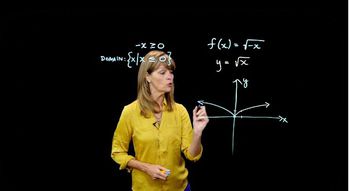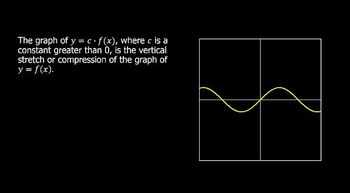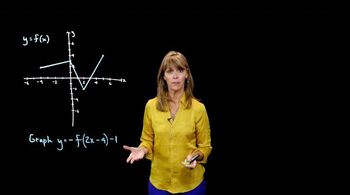Table of contents
- 0. Review of Algebra4h 16m
- 1. Equations & Inequalities3h 18m
- 2. Graphs of Equations43m
- 3. Functions2h 17m
- 4. Polynomial Functions1h 44m
- 5. Rational Functions1h 23m
- 6. Exponential & Logarithmic Functions2h 28m
- 7. Systems of Equations & Matrices4h 6m
- 8. Conic Sections2h 23m
- 9. Sequences, Series, & Induction1h 19m
- 10. Combinatorics & Probability1h 45m
3. Functions
Transformations
Problem 55b
Textbook Question
In Exercises 55–59, use the graph of to graph each function g. 
g(x) = f(x + 2) + 3
 Verified step by step guidance
Verified step by step guidance1
Identify the original function f(x) from the graph. Here, f(x) is a V-shaped graph with its vertex at (0,0).
Understand the transformation g(x) = f(x + 2) + 3. This involves two transformations: a horizontal shift and a vertical shift.
First, apply the horizontal shift. The term (x + 2) indicates a shift to the left by 2 units. So, shift the entire graph of f(x) 2 units to the left.
Next, apply the vertical shift. The +3 outside the function indicates a shift upwards by 3 units. So, shift the entire graph (after the horizontal shift) 3 units up.
Plot the new graph g(x) by combining both transformations. The vertex of the new graph will be at (-2, 3), and the shape of the graph will remain the same as f(x).
Recommended similar problem, with video answer:
 Verified Solution
Verified SolutionThis video solution was recommended by our tutors as helpful for the problem above
Video duration:
3mPlay a video:
Was this helpful?
Key Concepts
Here are the essential concepts you must grasp in order to answer the question correctly.
Function Transformation
Function transformations involve altering the graph of a function through shifts, stretches, or reflections. In this case, the function g(x) = f(x + 2) + 3 represents a horizontal shift to the left by 2 units and a vertical shift upward by 3 units. Understanding these transformations is crucial for accurately graphing the new function based on the original.
Recommended video:

Domain & Range of Transformed Functions
Vertex of a Function
The vertex of a function, particularly for quadratic functions like f(x), is the point where the graph changes direction. For the given function f(x), the vertex is at (0, 0). When transforming the function to g(x), the vertex will also shift according to the transformations applied, which is essential for determining the new position of the graph.
Recommended video:

Vertex Form
Graphing Techniques
Graphing techniques involve plotting points and understanding the shape of the function to create an accurate representation. For g(x), after applying the transformations to f(x), one can plot the new vertex and additional points to visualize the complete graph. Familiarity with these techniques helps in effectively translating the original graph to the transformed graph.
Recommended video:
Guided course

Graphs and Coordinates - Example

 5:25m
5:25mWatch next
Master Intro to Transformations with a bite sized video explanation from Nick Kaneko
Start learningRelated Videos
Related Practice

























